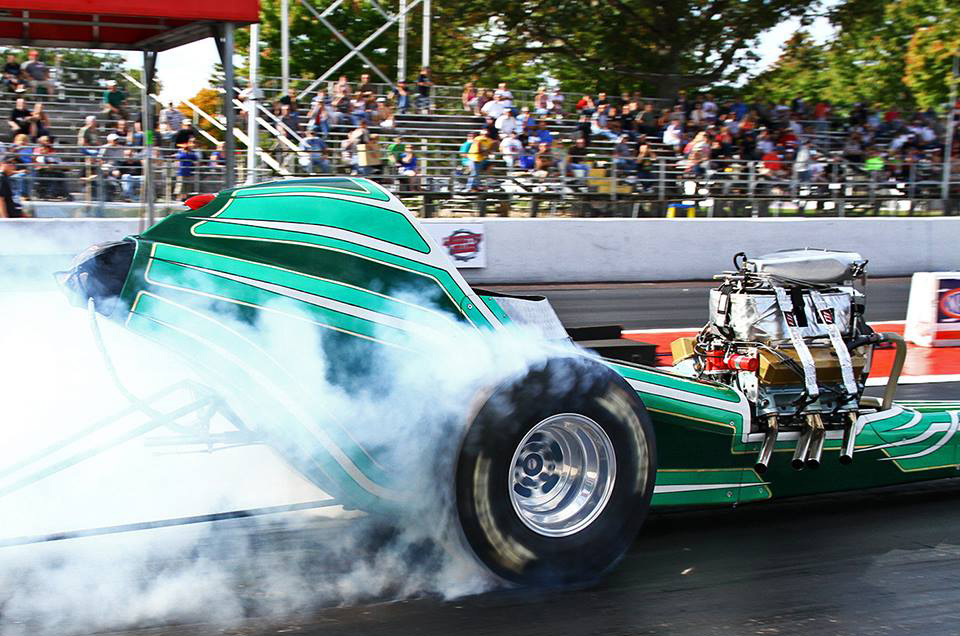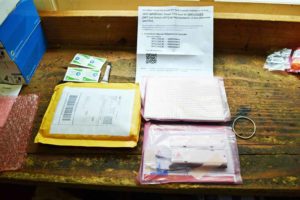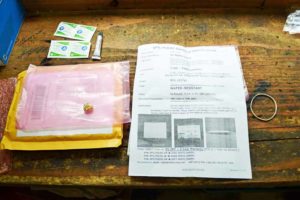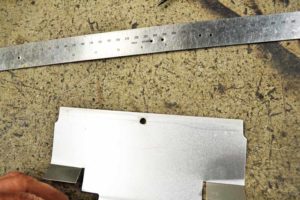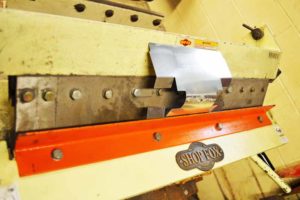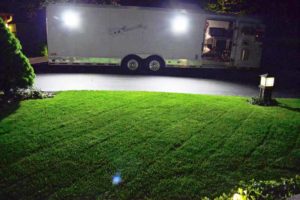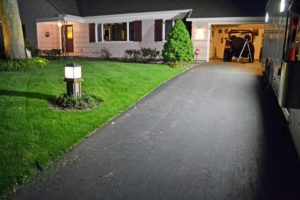LED Light Upgrade 2017 05 26
Click picture for larger image
So, time has come to do some upgrades to the lighting to the trailer. I want to put a camera inside the trailer so the stuff inside can be monitored as we drive down the road. There are some pretty rough roads in Ohio and Indiana. The inside of the trailer is dark when it is all closed up as one sky light is taken up with the A/C and the other is clear at the back of the trailer. The inside lights run off 12 volts and I have that connected to the 12 volt battery that runs the winch which is not charged as we travel down the road. I have decided to replace the inside filament bulbs with LED bulbs and will also replace the outside quartz halogen bulbs with LED panels. I’ll talk more about that when we get to that project; there are a lot of things to consider when doing this conversion.
So, let’s first talk about the inside 912 bulbs. First off the pictures are not a true representation of the brightness of the bulbs as the camera is trying to even out the brightness. The last picture in each discussion will be night shots which I hope gives a better idea of what the LED replacements are like.
My preconceived idea of LED lights is that they are very bright to look at, but do not throw as much light as a filament light does.
Below is the ceiling light in the trailer (there are four of them) with the 912 filament light. On the left the lens cover in place. Next to it on the right is the same fixture with the lens cover removed.
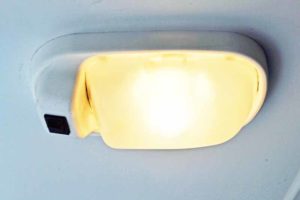
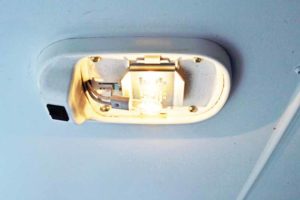
When I went to insert the LED 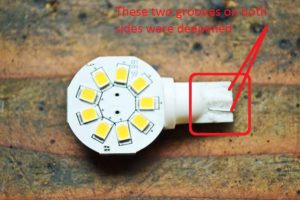 replacement bulb it would not fit into the socket. After taking some measurements I found that the contact grooves for the bulb were .030 too thick. I bent the contact wires straight, then took a die-grinder to deepen the groves and finally bent the contact wires back in place. The LED bulbs would then fit into the socket. Look carefully and you will see where I had to grind.
replacement bulb it would not fit into the socket. After taking some measurements I found that the contact grooves for the bulb were .030 too thick. I bent the contact wires straight, then took a die-grinder to deepen the groves and finally bent the contact wires back in place. The LED bulbs would then fit into the socket. Look carefully and you will see where I had to grind.
Below is the ceiling light in the trailer with the LED replacement lights. On the left the lens cover in place. Next to it on the right is the same fixture with the lens cover removed.
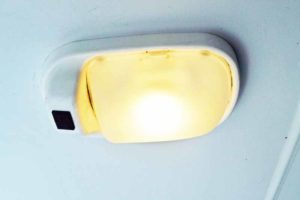
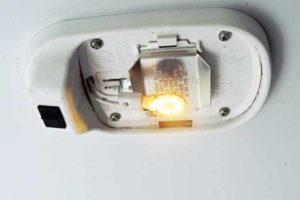
So on to the conversion of the external 500 watt Quartz Halogen lights. I did some reading and discovered quite a controversy over whether the LED panels available can actually be considered equal replacements.
The biggest complaint I came across was the amount of lumens the LED replacement panels produce.
The quartz halogen lights produce 10,000 lumens each, use 500 watts each, are extremely hot (when you walk by them you can feel the heat radiating out from them) and the Kelvin rating is around 3000K.
After some research, I found a replacement LED panel that produces 7,000 lumens, using 33 watts each with what they call a warm white of 4000 K.
Again, the big reason for making this change is to reduce power consumption.
This panel is produced by Solara, part number SPTL792LRC-4K. This panel when purchased directly from the manufacture gets a 5% discount off the Amazon price with an added second year on the warranty. He states it should last 35,000 hours of operation (16 years if run 6 hours a day). Just so you know, they are not inexpensive!
I have a (I hate to say foreign) Honda EU3000is generator. There just is no competitor to it. It is quiet, battery start, and I say again, quiet. With the quartz halogen lights on the little air compressor we have in the trailer struggles to start, but runs once it has started. It does occasionally trip the overload which means stopping the generator and restarting it.
I am hoping the swap to the LED panels resolves this problem.
The instruction manual is only on YouTube and leaves a lot to be desired. So let’s get started.
This is what you get in the mail. There 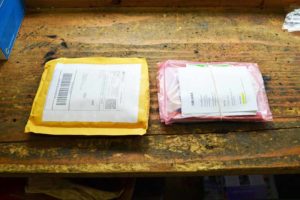 are two panels in this package.
are two panels in this package.
Again the pictures are deceiving as the 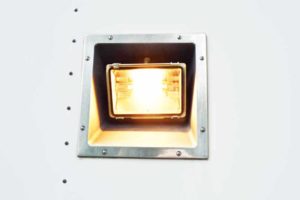 camera is trying to correct for the lights. See the last picture for a night time picture. This is the original quartz halogen light
camera is trying to correct for the lights. See the last picture for a night time picture. This is the original quartz halogen light
The first thing that has to happen is you need to get the glass cover off the front of the housing. Easier said than done. The spring clips are quite robust. I found that using a pair of needle nose pliers and inserting the end into the curl of the clip will allow you to swing the clip down. Be sure to hold onto the glass when you do this so it does not drop on the ground. With the glass removed the inside of the lamp is exposed.
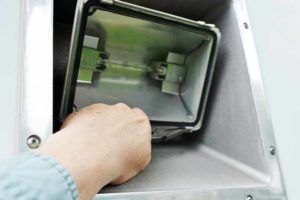
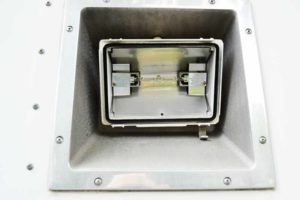
The quartz halogen bulb is removed by 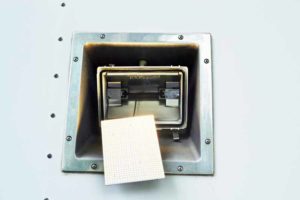 pressing the blub into the spring loaded socket and swing the other end of the bulb out of the socket. The LED panel adapter is then inserted into the socket just as if it was a replacement bulb and it is not polarized. I then tested the panel before proceeding. It is very bright, but remember my preconceptions (LEDs are bright to look at, but may not throw a lot of light, we will see tonight)
pressing the blub into the spring loaded socket and swing the other end of the bulb out of the socket. The LED panel adapter is then inserted into the socket just as if it was a replacement bulb and it is not polarized. I then tested the panel before proceeding. It is very bright, but remember my preconceptions (LEDs are bright to look at, but may not throw a lot of light, we will see tonight)
So what you are supposed to do 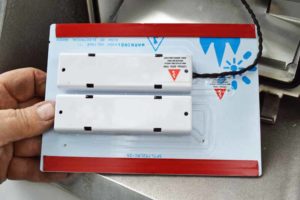 is to peal the tape backing off the light and stick it into the light. There are some problems with this. Mainly the inside of the fixture is on an angle which means very little of the tape makes contact with the fixture.
is to peal the tape backing off the light and stick it into the light. There are some problems with this. Mainly the inside of the fixture is on an angle which means very little of the tape makes contact with the fixture.
As it turns out the panel sits down 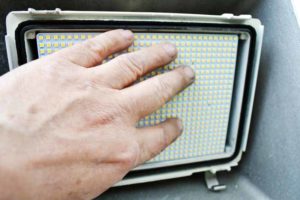 inside the fixture and that might be all right as the glass front would keep the LED panel from falling out. The panel actually sits down inside the fixture by about ¼ inch. I had the bright idea of using that ¼ to bend the reflector up to create more contact area
inside the fixture and that might be all right as the glass front would keep the LED panel from falling out. The panel actually sits down inside the fixture by about ¼ inch. I had the bright idea of using that ¼ to bend the reflector up to create more contact area
The whole reflector is held in place by 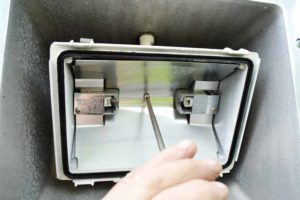 one screw and is easy to remove
one screw and is easy to remove
I scribed a line on both ends of the 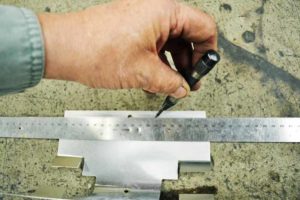 reflector ¼ inch in from the edge and stuck it in the break and bent the edge up to form a lip for the tape to stick to. If you do not have a brake, you could do this with a vise and a malate. Note I am not left handed, I just held the scribe with my left hand for the picture.
reflector ¼ inch in from the edge and stuck it in the break and bent the edge up to form a lip for the tape to stick to. If you do not have a brake, you could do this with a vise and a malate. Note I am not left handed, I just held the scribe with my left hand for the picture.
I bent the edges so that they formed a 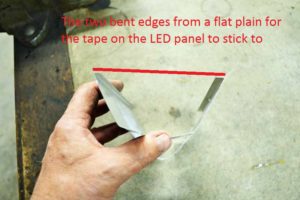 flat plain so that the LED panel would lay flat on the two lips.
flat plain so that the LED panel would lay flat on the two lips.
The reflector is reinstalled into the fixture. Now for a step completely left out of the YouTube instructions (I have provided the link to the instructions below) even though the alcohol wipes are provided in the package. The surface that the tape will stick to is cleaned with the alcohol wipes before the LED panel is installed.
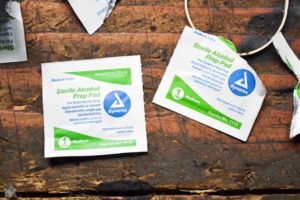
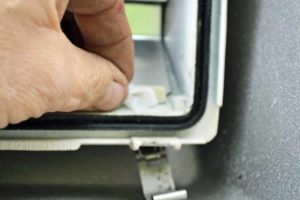
With reflector installed the LED adapter is refitted into the quartz halogen light socket and the panel is tested one more time.
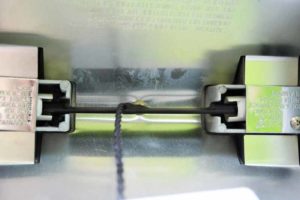
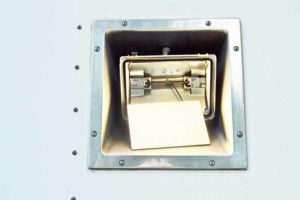
The tape backing is removed and the LED panel is placed up against the lips that were formed on the reflector. Left out of the YouTube instructions is that you should hold/press the tape against the surface the LED panel is be stuck to for at least 60 seconds. This insures good adhesion of the adhesive on the double stick tape.
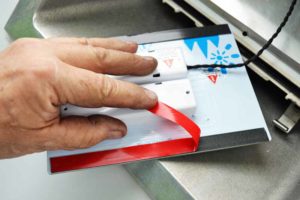
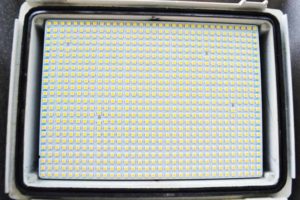
If the tape is not going to work for you, 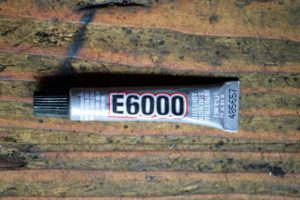 included in the package is some recommended glue. No instructions are given on how to use it. I would think what would be done is a bead of the glue would be laid and the LED panel set into it. I would call the customer support number before doing this: 562-881-5810
included in the package is some recommended glue. No instructions are given on how to use it. I would think what would be done is a bead of the glue would be laid and the LED panel set into it. I would call the customer support number before doing this: 562-881-5810
The glass for the fixture is reinstalled to 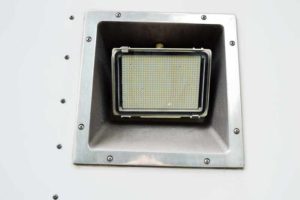 protect the LED panel. The LED panel is advertised to be water resistant
protect the LED panel. The LED panel is advertised to be water resistant
So left is a picture of the two outside quartz halogen fixtures on the outside of the trailer. One fixture has the LED panel in it the other has a quartz halogen bulb in it (the fixture on the Left has the LED panel in it). On the right is a picture with two LED Panels
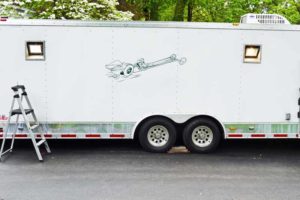
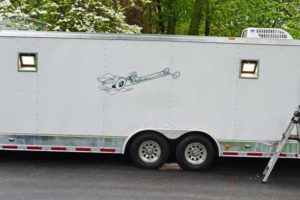
Ok, it is night and time to take some 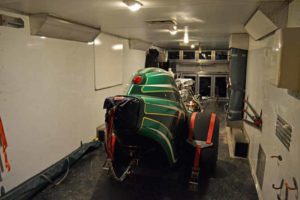 pictures. I was pleasantly surprised with the light. Other than the harshness on the light, and the outside lights are harsh, I am happy with the result.
pictures. I was pleasantly surprised with the light. Other than the harshness on the light, and the outside lights are harsh, I am happy with the result.
What do you think?
